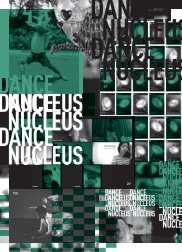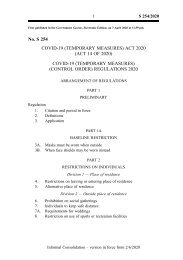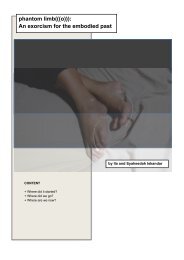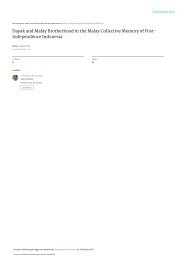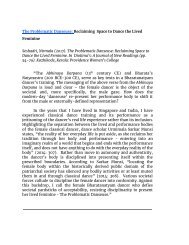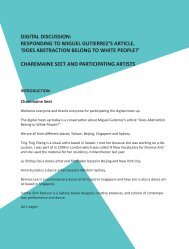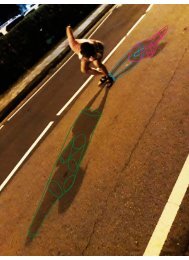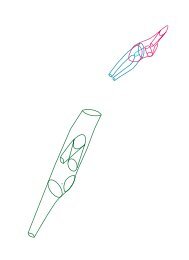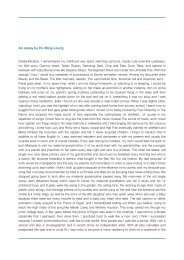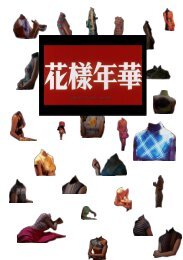FUSE#4
FUSE is a bi-annual publication that documents the projects at Dance Nucleus .
FUSE is a bi-annual publication that documents the projects at Dance Nucleus .
You also want an ePaper? Increase the reach of your titles
YUMPU automatically turns print PDFs into web optimized ePapers that Google loves.
FUSE #4<br />
dance with everyone in the room, seeking to meet the person, whether child<br />
or adult, where they are, and not taking for granted that everyone is moving<br />
the same way. Where in some other dance forms there are expectations that<br />
everyone is doing the same thing, Faye notes that in CI the skill is meeting the<br />
person as they are, with no necessity for a specific leader and follower, and<br />
intentionally replicates this in Rolypoly Family classes and jams where she<br />
warms kids up in those ways. Faye’s commitment to the pedagogical strategy<br />
of “I do we do you do” 8 is then a modeling of possibilities, allowing all who<br />
are present to decide for themselves, but also ceding to the collective energy<br />
of the room and what they make together.<br />
Thinking about agency and care as grounding this work with children,<br />
I considered both Faye’s practice within and outside her work with children<br />
as an ever-evolving whole, including the work of being a mother. For Faye,<br />
being a mother pertains not only to maternal labour but to the activistic involvement<br />
of her child in her work, driven by a need to be visible about this<br />
in order to fill certain gaps in spaces she inhabits. One of Faye’s challenges is<br />
being pigeonholed as a mother, and the potential overriding of this identity<br />
of that of an artistic maker, which came first for her but is now also deeply<br />
imbricated in the creative energies of motherhood. This is mirrored in the<br />
challenge of legibility faced by work for children to be seen as able to transcend<br />
its genre in terms of critical attention, visibility within an arts scene,<br />
and how it fits into the oeuvre of its makers and dedicated pedagogues. 9<br />
When Faye and I presented on our ongoing conversation at SCOPE #6, we<br />
posed the question of what it would look like if children were to become<br />
part of Dance Nucleus space, and the responses we received ranged from<br />
the political--those interested in the resistance and agency of children--to the<br />
personal, such as those who were artists and mothers and were interested in<br />
the boundaries between those aspects of their lives.<br />
The question of legibility and cultivating identifiable expertise is complex<br />
when one’s practice is as polyvalent as Faye’s, and even more so when<br />
labour and creativity is not neatly divided between public and domestic<br />
spheres. For one, motherhood in Faye’s conception is in part an attunement<br />
to vulnerability, risk, and boundary-traversing over time, a mode of being<br />
that overlaps with and informs creative life force. Faye questions why it is<br />
that women are scrutinised and disadvantaged when they are visible as a<br />
mother in certain spheres, and engages with the frustration and fear this<br />
question provokes through acts of negotiating the social contract of what<br />
it means to be a working artist in bringing her child into those spaces. She<br />
does so out of necessity, and with full knowledge that these acts of defiance<br />
may well be read as further evidence to see her as a mother and nothing but.<br />
Yet Faye continues to question and play around with the categories of artist<br />
and mother, asking “When and how does motherhood include artistic work,<br />
communities and networks? When and how does a working artist prevail and<br />
SCOPE<br />
thrive while being a caregiver? What are the social and domestic conventions<br />
that inhibit these?”<br />
One of Faye’s frequent collaborators is her son, who has made performances<br />
with her, such as Baby Bear Mama Bear. 10 This performance by Faye,<br />
Bernice Lee, and her son originated at Goodman Arts Center in Singapore,<br />
and was later performed in Vientiane with significant variation. When Faye<br />
and I shared our work at SCOPE, there was interest in the ways in which<br />
we were thinking about how the contract of the performer differs greatly<br />
when that performer is a child. This may be further highlighted by her son’s<br />
2019 staging of an original performance, Scooter Dance, in which he choreographed<br />
alongside Faye but ultimately chose not to perform, but rather<br />
to play on scooters with his friends on the day of the performance, due to<br />
several factors such as audience members whose invitation Faye had not discussed<br />
with him prior. As an artist who enjoys making with her son, Scooter<br />
Dance caused Faye to realise that the nature of this creative and maternal<br />
relation is an evolving one, in which her son’s independence and shifting interests<br />
will shift when, how, and what they make together. When I asked Faye<br />
how she would feel if her son was not as keen to collaborate on performing<br />
with her as he used to be in his current stage of life, she responded that she<br />
did not feel impatient for him to desire to do so again, and that in the meantime<br />
she was excited to grow many different sides of practice alongside him.<br />
She also noted that while her son’s growing independence contributes to his<br />
decisions to participate and perform, his prior participation in works such as<br />
Baby Bear Mama Bear did not necessarily correlate to greater agency than in<br />
non-participation of Scooter Dance. Faye also said of her son that he is “still<br />
very in his body and in his movement, but he is also doing a lot of creating<br />
outside of movement like writing books.” His creativity and expressivity in<br />
other areas also inspires Faye, and they continue to collaborate.<br />
For Faye and Bernice’s 2019 performance Letters Come Alive, Faye<br />
and her Rolypoly Family team were working on movements together with<br />
Bernice and Faye working on the structure and text. Her son came in to<br />
participate when the letters were made and scenes were in progress, and<br />
would join whenever there were new scenes to be workshopped. Faye noted<br />
that he influenced the work by way of his own playing and interaction with<br />
the work. For instance, he would make a shape that's different from what the<br />
adult performers did, and they would possibly incorporate it in place of their<br />
original idea. Faye wrote in her notes to me: “He has a sense of affinity with<br />
the work, wanting to play with the cards, have a set for himself, take the work<br />
to his school, etc. I think this is because he has had many opportunities to<br />
enjoy the work and have the freedom to interact with it the way he wants to.”<br />
She also shared that her son’s responses such as his laughter, eager physical<br />
participation and rapt attention gave them confidence as they were making<br />
the work, and gave them practice as to how to perform the work in the pres-<br />
99 100




